3 Minute Thesis 2016
2016 Presentations
Winner: Matt Johnson
Sociology goes to Space: Mining the Solar System and Enclosing the Space Frontier — Revolves around the notion of the ‘commons’, as it is expressed in international law and political economy

>> MATT JOHNSON Outer space is not a topic that gets much airtime in the arts and humanities. Questions of power, money, law and environment are generally overlooked. But in 2016, it’s an interesting time for the social study of outer space. What was once accessible by only the world’s superpower governments is now within reach of the private sector.
My project focuses on an emerging industry within this new space economy: space mining. Celestial bodies like moons and asteroids contain large volumes of valuable minerals like platinum and rare earths. Lured by this potential wealth, several US companies intend to prospect the space frontier, using these minerals to build space crafts and habitats outside the confines of Earth’s gravity, making possible, they believe, the colonisation and settlement of the cosmos.
But it’s pretty unlikely these companies will do so in the name of egalitarianism. Private property rights are what they seek, and just last year, their advocacy efforts came to fruition: President Obama signed into law an act that would permit those who access these minerals the right to sole ownership, use and sale.
But international law appears to forbid such an enclosure of space commons. Several UN treaties have declared outer space to be the province of all humankind. Our common heritage, not subject to claims of appropriation and ownership.
My research aims to do two things: first, it maps the net worth behind this push of private property rights in space. Is space colonisation just a pipe dream for wealthy nerds, pining to realise childhood dreams of living on the moon? Or is there a more powerful political alliance at play? One prominent example from my research is the company Planetary Resources, comprised of NASA know-how, seed funding from Google billionaires, and support of libertarian think tank the CATO institute. Google have enclosed our information commons through the sale, the privatisation of online data. CATO members like Rupert Murdoch and the Coke brothers have consistently opposed any notion of the public good. The idea that space mining would occur for the benefit of all humanity seems as fanciful as living on the moon once did.
Secondly, my project uses theoretical and historical research to investigate what it is that’s at stake in al this. Is the US making law by breaking law? Will outer space become the strict purview of wealthy elites, an endless frontier of resource exploitation, millions of kilometres away from red tape and democratic oversight? Is this policy just a means of perpetuating economic growth, where we don’t need to curtail pollution on earth because we can simply move elsewhere in the solar system?
And finally, what hope is there for reinvigorating the notion of the commons, where so many spheres of human and non-human life are commodified and sold to the highest bidder, could resistance to preserving the space commons help us to preserve those things we hold in common on earth?
Thank you.
[Applause]
First runner-up: Yi Zhang
From data to intelligence — seeks the way to apply advanced ITs (e.g., text mining and machine learning) to handle real-world problems in science, technology, innovation and policy research
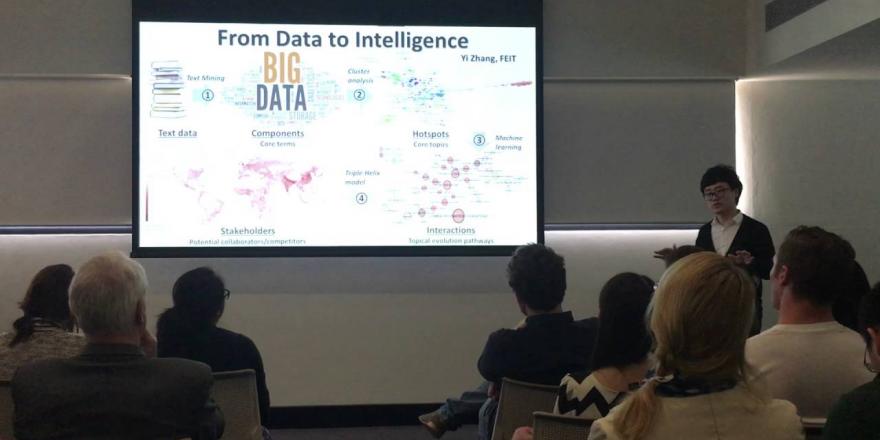
>> YI ZHANG Okay, let us think about the question about how many articles can you read in one day? Ten is good, right? So 100, amazing. So, how about a million?
Actually, it’s impossible for human beings to read a million articles in one day, but a machine can, and this is what my thesis attempts to do: to develop a machine, to read articles, to identify intelligence and support decision making.
We start from text to data, imagine the data you download from the UTS Library. Text-to-mining techniques are introduced to retrieve core terms, so-called components. [Inaudible] analysis is used to group these terms into certain ‘hotspots’, which can be some significant technologies or interesting topics.
But these are the questions of what are the articles talking about, and we want to know how they relate to each other. So machine learning techniques are used. Here we identify [inaudible] topical evolutionary pathways based on routines we can know the predecessor and the generations of our topic.
But we also can match the components, hotspots interactions with stakeholder information like individual, organisation, region and country. At this stage we can easily identify who holds the patters of the technology, which organisation is [inaudible] in the world or just in your country, and based on similarity analysis, we also can identify your possible collaborators or your possible competitors.
Yes, components, hotspots, interactions and stakeholder information are the intelligence we identified from the data, which can be great helpful for a wide range of science, technology, innovation and policy research for federal governments companies, academic institutions and researchers like you.
Thank you very much.
Second runner-up: Ian Cunningham
Strength-Based Approaches and Citizen-led Water Supply — alternative approaches to water supply in Indonesia and Solomon Islands

>> IAN CUNNINGHAM So back in 2008, I was given one of those very important life lessons, and the man who passed that to me was actually the head of a village water supply project in rural Indonesia. And we were talking about this project that we were working on together, and he said to me ‘This is our story — we need to be involved right from the beginning so we know both where we come from and where we’re going.’ And it was a really important moment for me personally. Essentially what he was saying was that his village, his community, actually needed to be active directors in the project we were working on, not passive subjects.
In subsequent years, working in international development, which is a discipline of aid and now the field of my research, I came to realise that sort of attitude he actually had was quite rare, and instead what is more common than that is actually defeatedness or dependence. And so I’ve been asking myself, how did we actually get to this situation? And I want to unpack that question a little bit with you together now through a very short human experiment.
So I want you to take a look at the words in the blue circles on the left-hand side, and just note how they make you feel. Village conflict, polluted water, poor management, broken water taps. When you read it, you feel the vibe in the room go down. And this is essentially a condensed version of an [inaudible] map — the starting point for an NGO when they define people and place for a project. You can imagine what it’s like to be repeatedly actually be defined like this by people coming into your place. It’s a really hard place to actually dream and think and move towards the future.
Now, by contrast, take a look at the words on the right-hand side — this is a strengths map. Energetic youth, enthusiastic local leadership, regular rainfall, beautiful river. By contrast, it’s uplifting — a much easier place to dream and move towards your ideal future.
Interestingly enough, these two maps are of exactly the same place, and my research is asking what if we started with the story on the right first — how would change look different? In particular, I’m interested in the role of strength-based approaches. They’re approaches that are based on what people care about and what’s worked in the past, and how that could be leveraged for citizen-led change.
My place within development is rural water supply — research shows it’s ripe for alternative approaches, where it’s common to see more than 50 per cent of rural supply systems failing, having a huge impact on wellbeing and poverty for literally hundreds of millions of people around the world. So, over the next three years, I’ll be conducting action-based research with NGOs in both the Solomon Islands and Indonesia to understand how strength-based approaches, starting with this story on the right, might bring creativity and alternative approaches to those suffering from water poverty.
[Applause]
Finalists
Anastasia Hronis
The Right to Good Mental Health: An Innovative Treatment for Children with Intellectual Disability — how psychological treatments can be adapted for children and adolescents who have an Intellectual Disability

>> ANASTASIA HRONIS Imagine that you’re the parent of a 12-year-old child. Recently, when they wake up in the morning, they tell you they feel sick to try and avoid going to school. They no longer want to go to their soccer matches or ballet classes because they’re worried about what the other children think of them. Slowly, they start to withdraw, their self-esteem drops and you notice that they’re not as happy as they once were. As a parent, what do you do? It may be that you seek out a referral for a mental health service that can help you and your child.
Now, imagine the same situation, only this time your child also has a disability. When you try to seek out mental health referrals, you realise that there are very few services that can help you, simply because your child also has a disability. Now, this is a significant issue, and one that I’m passionate about, because rates of mental illness for people with disabilities are particularly high — much higher than for the rest of the population.
My research looks at exactly this issue and asks, “What can we do about it?” In particular, I’m looking at how we can help children who have an intellectual disability. Intellectual disability means that someone has significant difficulty with learning and complex thinking. And they can struggle with everyday tasks. This can include children who also have disorders such as Down syndrome or autism.
Now, to date, very little research has been done looking at how we can provide psychological therapy for children with intellectual disabilities. And that’s where I come in. I’m currently developing and trailing a treatment program for these children. My research so far has found that by understanding how they learn and process information, we can tailor treatments to suit their needs. Now, we know that children with intellectual disabilities struggle when it comes to learning and concentrating, and what better way to engage kids these days than through technology? We want to take some of the key skills that we teach in therapy, and create an iPad application to be used in treatment. Now, the iPad application will be focused on how children think and feel, as is typically done in therapy. There will be four modules to complete over eight weeks, and we’ll evaluate how their mental health changes over time within standard psychological measures.
Initially, we’ll be trialling this program in schools that support children with special needs, and at the university [inaudible]. Essentially we want to provide children with the skills to help them challenge their thinking, face their fears, boost their self-esteem, and lead a healthy and happy life.
By doing all of this, hopefully we can start to help more and more children with disabilities around Australia to lead a healthy and happy life, because after all, everyone deserves the right to good metal health.
Thank you.
[Applause]
Dwi Linna Suswardany
Women with postnatal danger signs and traditional medicine — the use of traditional medicine for some communicable diseases and reproductive health problems in Indonesia by applying methods and principles derived from Public Health and Health Service Research
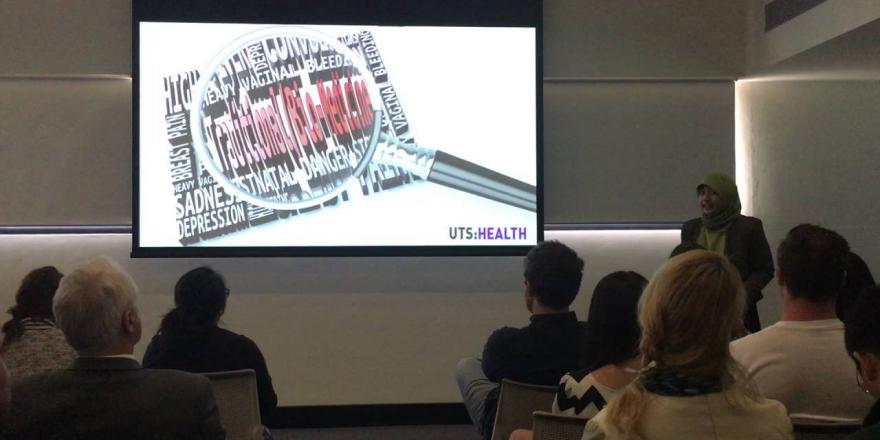
>> DWI LINNA SUSWARDANY Hello everyone. What comes to your mind when you hear the word postnatal? A cute baby? Happiness? For some women, it can be unbearable if they experience postnatal danger signs, such as heavy vaginal bleeding or depression.
In Indonesia, probably your local member will suggest that you take herbal medicine for these danger signs. And maybe you’ll say to them ‘Oh oh, no, no, I’ll stick to an evidence-based [inaudible], thank you!’ The postnatal period is a critical phase, and the most neglected time when many [inaudible].
Study shows, [inaudible] on the use of traditional medicine for mental health problems in Indonesia, but no study has focused on the use of traditional medicine for postnatal danger signs, and that’s where my study comes in. I use the Indonesian National Basic Health [inaudible] to analyse the problem prevalent characteristics of women who use traditional medicine for postnatal depression. Among more than 3000 women, 14.5 per cent of them used traditional medicine. My study confirmed that the economic status has a negative credit impact: with each increasing level of economic status, there is a significant reduction on the use of traditional medicine.
But is this merely about economic status? No. In my study, it’s not surprising that women who visit the traditional birth centre were much more likely to use traditional medicine. But interestingly, those who received a pregnancy examination at a medical doctor [inaudible] were also likely to use traditional medicine. Yes, further studies are needed to explore the underlying motivation, and this is [inaudible] on the use of traditional medicine for postnatal danger sign and to examine the interface within the use of traditional medicine and biomedical healthcare, plus to help ensure safe and effective care for postnatal women.
Now take a moment, just a moment. Think about postnatal women who live in a country where the [inaudible] are on 359 but 100 person [inaudible]. And imagine, if [inaudible] 5 million [inaudible], just like in Indonesia. And that’s the [inaudible] of this issue.
Thank you.
Jack Sugden
Trouble in Paradise? Sport for Integration in Fiji — Deals with the duality of sport in its potential to both unite and divide ethnic groups
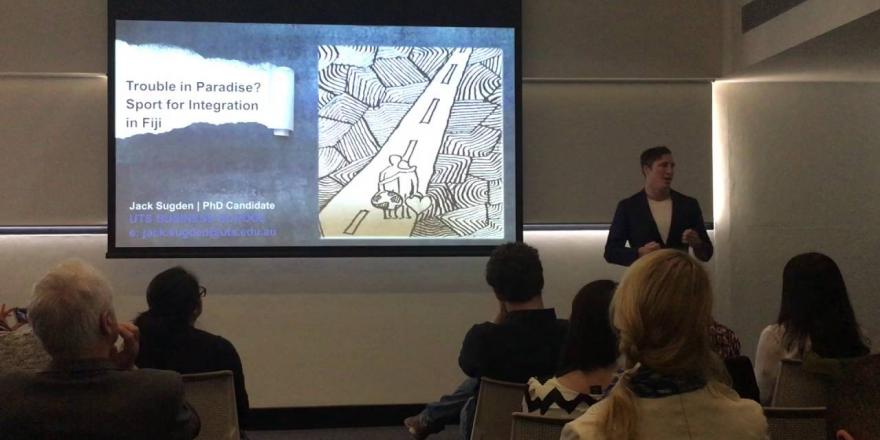
>> JACK SUGDEN Hi there. You could be forgiven for looking at the news [inaudible] and turning your head away in disgust at all the fear and vitriol and hatred that’s out there. This thesis engages with that dissent that occurs between groups around the world, but it also engages sport. Now, potential sports bring out the worst in us, and there’s also potential for sports to bring out the best in us. And this thesis really engages with that dynamic, that duality, the yin and yang. So to do this, I went to Fiji. Why Fiji? Well, it’s a lovely place to do research.
[Laughter]
No. I went to Fiji because for quite some time, it struggled with ethnic divisions, and at a real basic level it struggled to ferment a collective national consciousness. And sport has a role to play in that, because sport is a very powerful cultural commodity in Fiji. When you think of Fiji, you think of sandy beaches and sunny sunshine, but you also think of rugby straight away, and that’s quite important.
So to answer these questions, firstly you’ve got the meaning attached to sport and then the implications that this could have for integration. I thought well, I’ve got to go and invent myself in this society. The problem is, I’m this big old white berk, so going to Fiji and trying to understand these meanings people have towards sport can be quite difficult.
So to do that, I invented myself in the society as much as possible. I conducted around 48 semi-structured interviews, but more importantly I lived, ate, socialised, trained and even coached with the Indo-Fijian people, Fijian, Indigenous people from all over Fiji. And what I found was quite startling: I found that sport in Fiji actually reinforced and recycled ethnic division between Indigenous Fijians and Indo-Fijians on a very grand scale, from grassroots level to institutional level to decision-making level, this was happening.
And what that told me was there were going to be several opportunities where sport could be reframed. These opportunities were described to me by Fijian people, because part of the research process [inaudible] I can’t make judgements about people’s lives, so let’s bring them with me on this process of knowing, this process of knowledge, so that people in Fiji could become part of the process of knowledge construction, rather than just the object of research.
So what I found was the primary schools, they told me, Indo-Fijian kids wouldn’t even play sport — ‘We don’t play sport; we’re Indian.’ Whereas Indigenous Fijians were portrayed as these big, powerful, stereotypical, brawny, quite stupid people, like ‘Sports for us — you’re Indian, [inaudible] education economics is for you.’ And that was where [inaudible].
But the opportunities in schools to reform the schools’ education system in sport were there. Also the ethnocentrism and ethnic favouritism in major sports organisations was highlighted. But if we can do this we can really put a magnifying glass on the things in our society which unite us, which are powerful that what divides us.
Thank you.
[Applause]
Naomi Koh Belic
Multiple sclerosis: a disease in a dish — creating a disease in a dish model of multiple sclerosis, consequently allowing for extensive analysis which can provide insights into the disease
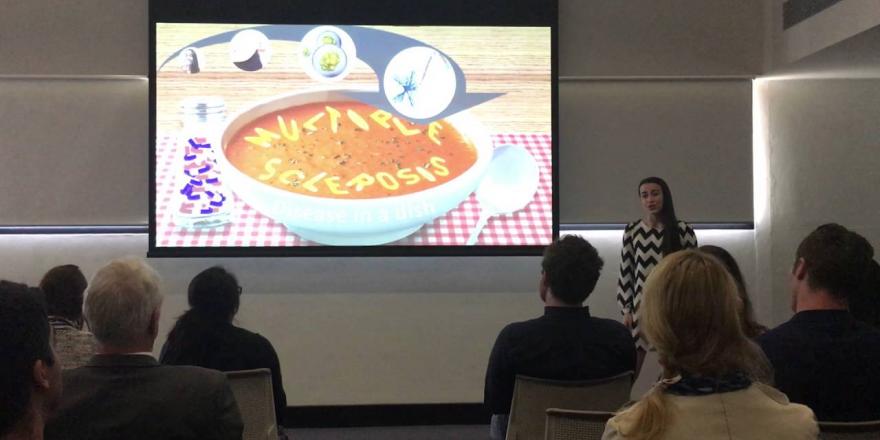
>> NAOMI KOH BELIC Hey guys. My name is Naomi Koh Belic, and like most people in this room, my life revolves around food. I eat when I’m happy, I eat when I’m sad, I eat when I’m bored, and if I could, I’d even eat in my sleep.
Now, we all know it’s easy to put on a little bit of weight when we’re eating, like this fellow up here. What you probably don’t realise is how valuable your fat can be.
My research is focused on stem cells, which you can get straight from your fat. Stem cells have the ability to turn into all different kind of cells, given the right environment, and I look at turning stem cells from your fat into neurons, the cells that are found your brain. I’m able to grow these neurons in a dish, [inaudible] analyse them in really great detail.
Now, I look at doing this process with multiple sclerosis patients. Most of you here have probably heard of multiple sclerosis, or more simply MS. [inaudible] people are affected by it. For those of it who aren’t familiar, MS is a chronic disease of the central nervous system, and it can manifest in a lot of different ways.
What I find most confronting is how little we actually know about MS. Now, it’s not surprising that we don’t really understand MS, as it’s really hard to get pieces of brain tissue from patients, and it’s difficult to create an animal model of a disease we don’t really understand. So in my PhD, I’ve been working to resolve this. I’ve had a handful of volunteers with MS, they’ve had some complimentary liposuction, and their fat has been sent [inaudible]. I’ve taken the stem cells out of the fat, and turned them into neurons, allowing for me to create my disease in a dish. Now, you can [inaudible] my disease in a dish, much like a bowl of soup.
If you examine and analyse this soup, you’ll eventually be able to work out the ingredients that make up the soup, and even develop an idea of what ingredients can be added to make that soup better. I try and do the same thing with my disease in a dish. By developing a better understanding of what makes up MS, comparing these to healthy samples to see what’s different, to get an idea of what treatments can then be added.
Now, developing this better understanding of MS is vital because it will create avenues for better and more effective treatments for patients. It’s a no-brainer, really, but if all this is stressing you out, don’t forget. Stress [inaudible] with desserts, so treat yourself so we can treat MS.
[Applause]
Xiaoyu Gu
Smart base isolation system: the ultimate seismic protection — Base isolation is the most widely adopted approach to protect civil structures and human lives from seismic attack
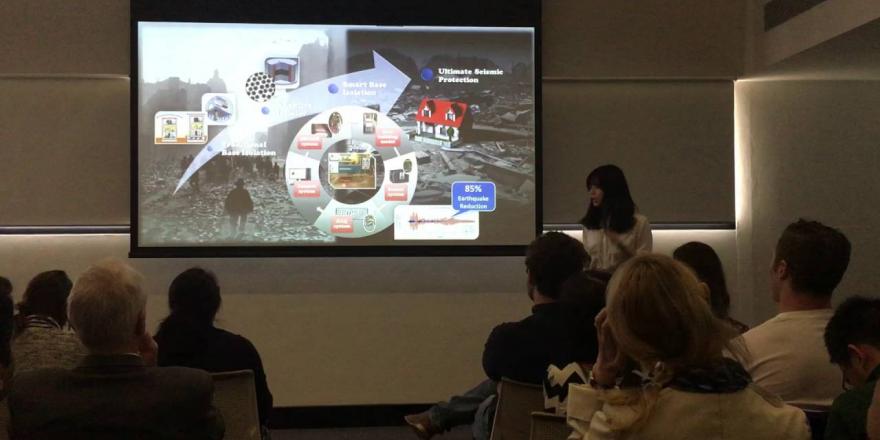
>> XIAOYO GU Do you know that during next few minutes, there will be more than 30 earthquakes happening around the world?
When confronted with natural power, we human beings are extremely vulnerable and helpless. This picture shows San Francisco flattened by the earthquake in 1906. When [inaudible] China earthquake 2008, 67,000 lives. Nepal earthquake last year, 8000 lives, with 80,000 still suffering the consequences.
So, how can we protect ourselves? Luckily there is one solution: base isolation. The reason why buildings collapse during earthquakes is because of the massive energy transmitted into the structure, through the rigid connection between the building and the ground. So what base isolation do here is to make the connection flexible to cut off the energy transmission. Just imagine just with the base isolation system, we are able to trap the monster of earthquakes under the ground.
However, the traditional base isolation system is designed based on only one type of earthquakes. So we will encounter serious problems in another one. This is like a dumb and stubborn person with excellent body function and physical fitness that will not react to different external environments.
So my research is to change the existing base isolation system from dumb and passive into smart and active. How do we do that? Our team has prototyped the world’s first adaptive base isolator. The core of this isolator contains an amazing smelt rubber, whose stiffness can be controlled by the magnetic field. With such a property, this device can provide different flexibilities for the building according to the characteristics of the earthquake.
The effectiveness of this isolation is demonstrated when I implemented it under a real building model to form a smart base isolation system. So now, you guys do remember that dumb person with passive isolators? This time he is equipped with different displacement and exo-region sensors to make him able to see and feel the earthquake citations and his only movement, and most importantly, different control algorithms have been implemented in his brain and endow him in [inaudible] intelligence to [inaudible] all kinds of earthquakes.
Testing has shown that my system can acquire the 85 per cent [inaudible] reduction when compared to traditional ones. So now, [inaudible], I can design a base isolation system and ensure you that you and your house are perfectly safe.
Thank you.
[Applause]
Yu Gao
Villages Ties in the City: Lived Space in the Pearl River Delta — redefines the ‘villageness’ inside the world largest urban area via tracing the dragon boat activities that keep the villages alive inside the city

>> YU GAO Hi everyone.
Have you ever considered paddling a dragon boat has a meaning more than just for fun or exercise? In 2010, the World Bank reported that [inaudible] area, and this is where I conduct my research, which looks for culture and identity coherence in relation to social transformation.
My research has found that some sport activities such as paddling the dragon boat is significant in building [inaudible] between villages that keep the villages alive in the city. My research also challenges what [inaudible] area should look like, especially for developing countries where the government and planners pursue development [inaudible] villages to build up new urban [inaudible].
If you take a closer look at the flag on the boat, you will see a name — a name of a village. [Inaudible] has already been devoured by the urban transformation process and its name has been lost from the map. There are plenty of literature focused on [inaudible] new urban landscape, and they all assume that villages inside a city [inaudible] are isolated islands and they will die completely after the urban transformation process.
But the villagers don’t seem to think so, even though they’re now living in high-rise model apartments, their previous farmland has converted into the new CBD of the city. Each year at festivals even they still hop on their dragon boat, paddling their dragon boat, representing their villages, following the water racing [inaudible] brothers’ or friends’ village. This is all followed by boisterous scenes with firecrackers and [inaudible] banquets. It’s just like we’re going to a friend’s party.
My research has found that each village’s dragon boat [inaudible] each year, and the host villages also act as a guest village. There are more than 100 villages inside of city; however, it is only a few days of the festival season that emerge into [inaudible] before [inaudible] into the urban context for another year. I have followed the dragon boat, visiting 16 villages so far, and as you know, for me to draw a new map of the city, a map of the village in the world’s largest urban area.
So next time there’s [inaudible] wipe-out all the villages in a certain place, keep in mind that it might just have left the dragon boat. Thank you.
[Applause]
